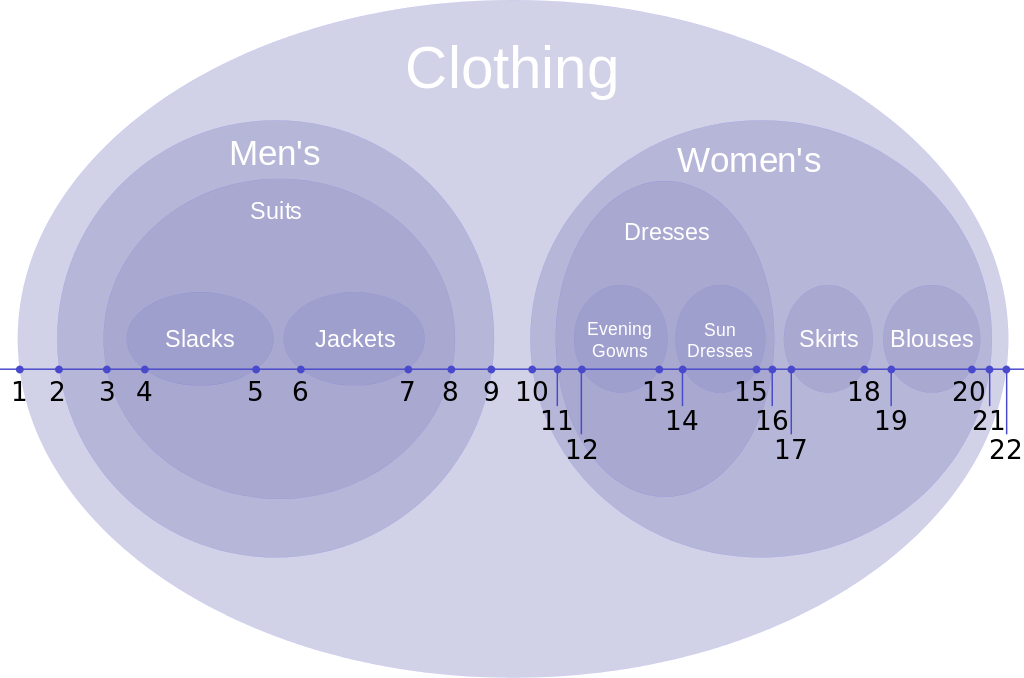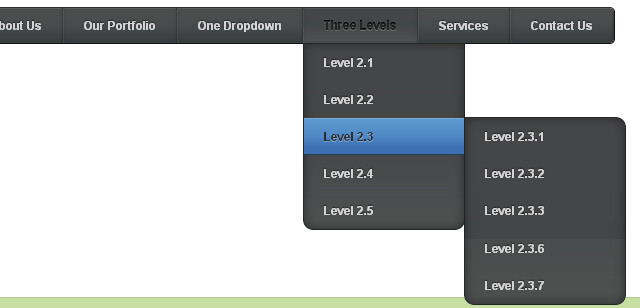laravel implements infinite classification
Explanation
Everyone usually uses recursion to implement infinite classification. We all know that recursion is very inefficient. Here is a Laravel expansion package recommended etrepat/baum, quickly make your data model support infinite tree hierarchical structure while taking into account efficiency.
Using the Baum nested set model to implement the infinite classification of the Laravel model
The official documentation of the expansion package has explanation space, and the picture below is also one Simple example:

Use case description
# Next, let’s talk about a few examples of infinite tree hierarchical models.
Tag system
#Reference: Laravel Taggable Adds tagging function to your model. A tag can have countless child tags, belong to one parent tag, and have multiple peer tags.
For example, the tag tree below:
$tagTree = [
'name' => 'RootTag',
'children' => [
['name' => 'L1Child1',
'children' => [
['name' => 'L2Child1'],
['name' => 'L2Child1'],
['name' => 'L2Child1'],
]
],
['name' => 'L1Child2'],
['name' => 'L1Child3'],
]];Comment system
#Infinitely nested comments, such as NetEase's comment system.

Laravel has a comment extension that supports unlimited nesting, see Slynova-Org/laravel-commentable.
「Navigation bar」data model
#The administrator backend needs to provide the customization function of "Navigation bar", a tree-structured navigation bar.

Integrate Baum
#etrepat/baum Quickly make your data model support the infinite tree hierarchical structure while taking into account efficiency.
Next let’s talk about how to integrate.
1. Composer installation
#composer require "baum/baum:~1.1"
2. Add provider
#Modify the config/app.php file in providers Add to the array:
'Baum\Providers\BaumServiceProvider',
This service provider has registered two commands: artisan baum, artisan baum.install.
3. Create migration
#Install it on the existing data model:
php artisan baum:install MODEL
Then execute
php artisan migrate
Field introduction about migration
#parent_id: the id of the parent node
lft: the left index value
rgt: the right index value
depth: Hierarchical depth
The following is an example:
class Category extends Migration {
public function up() {
Schema::create('categories', function(Blueprint $table) {
$table->increments('id');
// 这四行代码
$table->integer('parent_id')->nullable();
$table->integer('lft')->nullable();
$table->integer('rgt')->nullable();
$table->integer('depth')->nullable();
$table->string('name', 255);
$table->timestamps();
});
}}4. Configure the data model
#Inherit Baum\Node
class Category extends Baum\Node {}After inheritance, these properties can be overridden:
class Category extends Baum\Node {
protected $table = 'categories';
// 'parent_id' column name
protected $parentColumn = 'parent_id';
// 'lft' column name
protected $leftColumn = 'lidx';
// 'rgt' column name
protected $rightColumn = 'ridx';
// 'depth' column name
protected $depthColumn = 'nesting';
// guard attributes from mass-assignment
protected $guarded = array('id', 'parent_id', 'lidx', 'ridx', 'nesting');}The integration is successful.
Use
$root = Tag::create(['name' => 'Root']);
// 创建子标签
$child1 = $root->children()->create(['name' => 'Child1']);
$child = Tag::create(['name' => 'Child2']);
$child->makeChildOf($root);
// 批量构建树
$tagTree = [
'name' => 'RootTag',
'children' => [
['name' => 'L1Child1',
'children' => [
['name' => 'L2Child1'],
['name' => 'L2Child1'],
['name' => 'L2Child1'],
]
],
['name' => 'L1Child2'],
['name' => 'L1Child3'],
]
];
Tag::buildTree($tagTree);
Hot AI Tools

Undresser.AI Undress
AI-powered app for creating realistic nude photos

AI Clothes Remover
Online AI tool for removing clothes from photos.

Undress AI Tool
Undress images for free

Clothoff.io
AI clothes remover

Video Face Swap
Swap faces in any video effortlessly with our completely free AI face swap tool!

Hot Article

Hot Tools

Notepad++7.3.1
Easy-to-use and free code editor

SublimeText3 Chinese version
Chinese version, very easy to use

Zend Studio 13.0.1
Powerful PHP integrated development environment

Dreamweaver CS6
Visual web development tools

SublimeText3 Mac version
God-level code editing software (SublimeText3)

Hot Topics
 How to get the return code when email sending fails in Laravel?
Apr 01, 2025 pm 02:45 PM
How to get the return code when email sending fails in Laravel?
Apr 01, 2025 pm 02:45 PM
Method for obtaining the return code when Laravel email sending fails. When using Laravel to develop applications, you often encounter situations where you need to send verification codes. And in reality...
 Laravel schedule task is not executed: What should I do if the task is not running after schedule: run command?
Mar 31, 2025 pm 11:24 PM
Laravel schedule task is not executed: What should I do if the task is not running after schedule: run command?
Mar 31, 2025 pm 11:24 PM
Laravel schedule task run unresponsive troubleshooting When using Laravel's schedule task scheduling, many developers will encounter this problem: schedule:run...
 In Laravel, how to deal with the situation where verification codes are failed to be sent by email?
Mar 31, 2025 pm 11:48 PM
In Laravel, how to deal with the situation where verification codes are failed to be sent by email?
Mar 31, 2025 pm 11:48 PM
The method of handling Laravel's email failure to send verification code is to use Laravel...
 How to implement the custom table function of clicking to add data in dcat admin?
Apr 01, 2025 am 07:09 AM
How to implement the custom table function of clicking to add data in dcat admin?
Apr 01, 2025 am 07:09 AM
How to implement the table function of custom click to add data in dcatadmin (laravel-admin) When using dcat...
 Laravel Redis connection sharing: Why does the select method affect other connections?
Apr 01, 2025 am 07:45 AM
Laravel Redis connection sharing: Why does the select method affect other connections?
Apr 01, 2025 am 07:45 AM
The impact of sharing of Redis connections in Laravel framework and select methods When using Laravel framework and Redis, developers may encounter a problem: through configuration...
 Laravel Eloquent ORM in Bangla partial model search)
Apr 08, 2025 pm 02:06 PM
Laravel Eloquent ORM in Bangla partial model search)
Apr 08, 2025 pm 02:06 PM
LaravelEloquent Model Retrieval: Easily obtaining database data EloquentORM provides a concise and easy-to-understand way to operate the database. This article will introduce various Eloquent model search techniques in detail to help you obtain data from the database efficiently. 1. Get all records. Use the all() method to get all records in the database table: useApp\Models\Post;$posts=Post::all(); This will return a collection. You can access data using foreach loop or other collection methods: foreach($postsas$post){echo$post->
 Laravel multi-tenant extension stancl/tenancy: How to customize the host address of a tenant database connection?
Apr 01, 2025 am 09:09 AM
Laravel multi-tenant extension stancl/tenancy: How to customize the host address of a tenant database connection?
Apr 01, 2025 am 09:09 AM
Custom tenant database connection in Laravel multi-tenant extension package stancl/tenancy When building multi-tenant applications using Laravel multi-tenant extension package stancl/tenancy,...
 Laravel's geospatial: Optimization of interactive maps and large amounts of data
Apr 08, 2025 pm 12:24 PM
Laravel's geospatial: Optimization of interactive maps and large amounts of data
Apr 08, 2025 pm 12:24 PM
Efficiently process 7 million records and create interactive maps with geospatial technology. This article explores how to efficiently process over 7 million records using Laravel and MySQL and convert them into interactive map visualizations. Initial challenge project requirements: Extract valuable insights using 7 million records in MySQL database. Many people first consider programming languages, but ignore the database itself: Can it meet the needs? Is data migration or structural adjustment required? Can MySQL withstand such a large data load? Preliminary analysis: Key filters and properties need to be identified. After analysis, it was found that only a few attributes were related to the solution. We verified the feasibility of the filter and set some restrictions to optimize the search. Map search based on city






